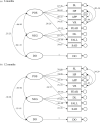Examining the factor structure and discriminative utility of the Infant Behavior Questionnaire-Revised in infant siblings of autistic children
- PMID: 35485579
- PMCID: PMC9544485
- DOI: 10.1111/cdev.13781
Examining the factor structure and discriminative utility of the Infant Behavior Questionnaire-Revised in infant siblings of autistic children
Abstract
Using the Infant Behavior Questionnaire-Revised in a longitudinal sample of infant siblings of autistic children (HR; n = 427, 171 female, 83.4% White) and a comparison group of low-risk controls (LR, n = 200, 86 female, 81.5% White), collected between 2007 and 2017, this study identified an invariant factor structure of temperament traits across groups at 6 and 12 months. Second, after partitioning the groups by familial risk and diagnostic outcome at 24 months, results reveal an endophenotypic pattern of Positive Emotionality at both 6 and 12 months, (HR-autism spectrum disorder [ASD] < HR-no-ASD < LR). Third, increased 'Duration of Orienting' at 12 months was associated with lower scores on the 24-month developmental outcomes in HR infants. These findings may augment efforts for early identification of ASD.
© 2022 The Authors. Child Development published by Wiley Periodicals LLC on behalf of Society for Research in Child Development.
Figures



References
-
- American Psychiatric Association . (2013). Diagnostic and statistical manual of mental disorders: DSM‐5. American Psychiatric Association.
-
- Bosquet Enlow, M. , White, M. T. , Hails, K. , Cabrera, I. , & Wright, R. J. (2016). The Infant Behavior Questionnaire‐Revised: Factor structure in a culturally and sociodemographically diverse sample in the United States. Infant Behavior and Development, 43, 24–35. 10.1016/j.infbeh.2016.04.001 - DOI - PMC - PubMed
-
- Bryson, S. , Garon, N. , McMullen, T. , Brian, J. , Zwaigenbaum, L. , Armstrong, V. , Roberts, W. , Smith, I. , & Szatmari, P. (2018). Impaired disengagement of attention and its relationship to emotional distress in infants at high‐risk for autism spectrum disorder. Journal of Clinical and Experimental Neuropsychology, 40, 487–501. 10.1080/13803395.2017.1372368 - DOI - PubMed

